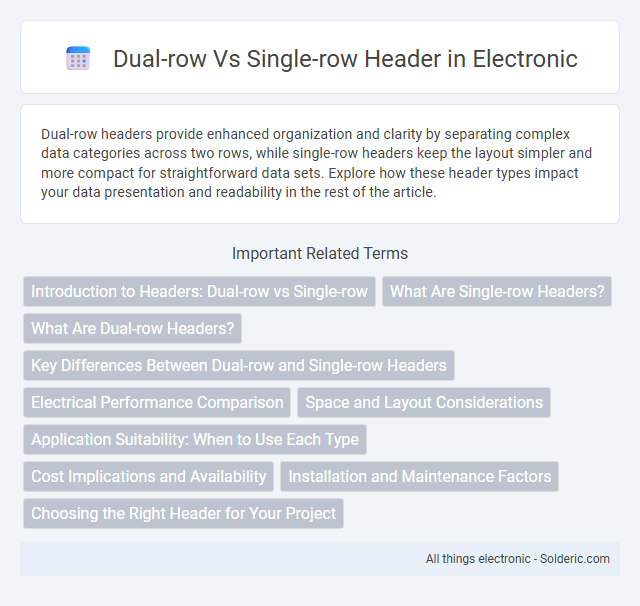Dual-row headers provide enhanced organization and clarity by separating complex data categories across two rows, while single-row headers keep the layout simpler and more compact for straightforward data sets. Explore how these header types impact your data presentation and readability in the rest of the article.
Comparison Table
| Feature | Dual-row Header | Single-row Header |
|---|---|---|
| Structure | Two rows of header cells | One row of header cells |
| Complexity | More complex, suitable for categorizing data | Simple and straightforward |
| Readability | Improves clarity for grouped data | Best for simple datasets |
| Use Case | Multi-category tables, hierarchical data | Simple, flat data tables |
| HTML Implementation | Uses rowspan and colspan attributes | Single set of <th> tags |
| Screen Reader Compatibility | Requires proper markup for accessibility | Generally easier to interpret |
Introduction to Headers: Dual-row vs Single-row
Single-row headers provide a straightforward, concise structure ideal for simple datasets, offering clear column labels in one horizontal line. Dual-row headers enhance data organization by splitting header information into two levels, allowing you to categorize and subcategorize columns for improved readability and detailed context. Choosing between dual-row and single-row headers depends on the complexity of your data and the clarity required for effective analysis.
What Are Single-row Headers?
Single-row headers display column titles in a single horizontal line, simplifying the table's structure and improving readability. They are ideal for datasets with fewer categories, enabling quicker data scanning and easier alignment. Your choice depends on the complexity of the information and how quickly users need to interpret column labels.
What Are Dual-row Headers?
Dual-row headers consist of two horizontal rows of column labels, allowing more detailed categorization of data compared to single-row headers. They enhance data readability and organization by grouping related columns under broader categories in the top row, with specific sub-labels in the second row. Your spreadsheets benefit from improved clarity and easier navigation when using dual-row headers, especially in complex datasets.
Key Differences Between Dual-row and Single-row Headers
Dual-row headers provide more labeling space allowing for clearer categorization of complex data, whereas single-row headers occupy less vertical space and are simpler to design. Dual-row headers enhance readability by grouping related columns under a common header, improving user navigation in large datasets. Single-row headers are more suitable for straightforward tables with fewer columns due to their compact layout and ease of implementation.
Electrical Performance Comparison
Dual-row headers provide improved electrical performance by reducing signal crosstalk and enhancing current-carrying capacity compared to single-row headers. The closer pin spacing in dual-row configurations allows for better grounding and signal integrity, minimizing noise and electromagnetic interference in high-speed applications. Your choice of a dual-row header can optimize circuit reliability and support higher frequency signals more effectively than single-row designs.
Space and Layout Considerations
Dual-row headers maximize vertical space by stacking header information, allowing more columns to fit without horizontal scrolling, which is ideal for complex data tables. Single-row headers save vertical space and create a cleaner look, but may require wider columns, impacting horizontal layout and readability. Choosing between them depends on your content density and whether you prioritize compactness or clarity in your table design.
Application Suitability: When to Use Each Type
Dual-row headers are ideal for complex data tables where categorization and grouping of related information enhance readability, making them suitable for financial reports, project timelines, and multi-dimensional datasets. Single-row headers work best in simple tables with straightforward, limited columns, such as basic inventories or contact lists, where clarity and space efficiency are priorities. Choosing between dual-row and single-row headers depends on the data complexity and the need to visually separate and organize distinct categories within the dataset.
Cost Implications and Availability
Dual-row headers generally involve higher manufacturing costs due to increased complexity and additional components, making them less common in budget-sensitive applications. Single-row headers offer greater availability and cost-effectiveness, making them the preferred choice for standard, mass-produced electronic devices. When selecting your header type, consider the balance between cost constraints and the availability of specific configurations to optimize your project.
Installation and Maintenance Factors
Dual-row headers typically require more precise installation due to their increased complexity and weight, which may necessitate specialized tools or expertise compared to single-row headers. Maintenance of dual-row headers can be more time-consuming and costly as they contain more components prone to wear, while single-row headers offer easier access and simpler upkeep, reducing downtime. Evaluating your operational needs and maintenance capabilities will help determine which header type aligns better with your installation and long-term maintenance goals.
Choosing the Right Header for Your Project
Choosing between a dual-row and single-row header depends on the complexity and data presentation requirements of your project. Dual-row headers offer enhanced organization by categorizing information into multiple tiers, making them ideal for large datasets with numerous variables. Single-row headers provide simplicity and faster comprehension, suitable for straightforward data sets or when space is limited.
Dual-row vs Single-row header Infographic

 solderic.com
solderic.com